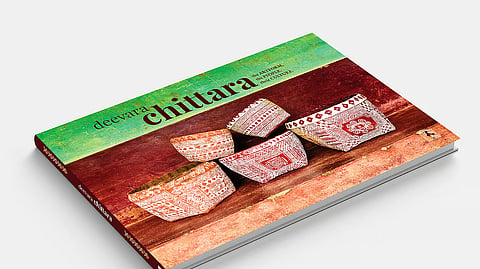

In the mud walls of many remote homes nestled in Karnataka’s Malanadu region, stories bloom in delicate strokes of white and ochre. Beyond the mere decor appeal, they are imprints of a community’s soul. Known as chittara, the intricate mural art, practised by the Deevaru women, is a visual language that encodes centuries of ecological wisdom, cultural ritual, and mathematical symmetry blended into art on walls, reports Anjali Ram of The New Indian Express.
Now, through a book titled Deevara Chittara: The Artform, The People, Their Culture (₹5,995, Prism Books), the chronicle of this art practice has become as intricate as the community that creates it. Far from a glossy coffee table ornament, the 200-page volume inscribed the wisdom and creativity of the Deevaru women of Karnataka’s Malanadu region, alongside a deep reverence for nature in the symmetrical patterns of chittara art. With traditional phrases, elements and motifs introduced in colloquial Kannada with translation in simple English, the book comes with a glossary and a link to the website for audio and video resources.
The book’s journey began with a two-decade-long conviction held by co-author Geetha Bhat, a veteran researcher in the field. “This artform is so rich, and it also has so many things to teach us,” she explains, adding, “It has been my wish for quite a few years that I need to bring out a book covering all the aspects about chittara in particular, about the eco-friendly crafts and how much people take nature relationship and their whole lifestyle connected with nature.” The objective was never merely to document paint, but to capture the entire cultural ecosystem that nurtures it.
Chittara, a folk art traditionally done by women, is a marvel of geometric precision. The most significant iteration, the Hasegode Chittara, which is painted during weddings, is a symmetrical structure that draws heavily from local house architecture. Co-author and visual narrator Smitha Tumuluru notes that it’s inherently mathematical: “It has vertical symmetry for aesthetics, and whatever math is involved works towards the aesthetic of the chittara.”
Each motifs transform life into a symbol, and the commitment of the women to this symbolic language is profound. Nili kocchu represents the criss-cross lines of walls built from bamboo, while poppali, the distinctive pattern, is variously interpreted as the interplay of light and shadow or the stars in the sky, a reminder of ancestral protection. “Poppali is like a chessboard pattern, it has to be symmetric and you have to fill it with alternates,” adds Bhat.
Every aspect of their agrarian life is chronicled in the art. Even something as subtle as a woman’s hair bun or the after harvest paddy structures called gonabe – finds its way into the intricate designs. This connection to the land is celebrated in festivals like the Bhoomi Hunnime Habba (Earth’s Baby Shower), where offerings are carried in Bhoomanni Butti baskets decorated with chittara designs narrating the story of the harvest.
Noting the feminine strength behind the art, Namrata Cavale, designer and illustrator of the book, shares, “Gowramma Hucchappa Masther, senior chittara artist, recalled these lines once: ‘Hagalella madhuve kelasa katapate. Ratri, haralenne deepadha belakalli chittarada kelasa.’ It goes to show the dedication of the Deevaru women back in the day, to painting and developing chittara even after a hard day’s work, in the mere light of an oil lamp.”
From finding the authentic chittara varieties with modernisation and lack of practice to meeting artistes, the creation of the book was nothing less than an archaeological excavation of a vanishing culture for the curators. “There is no doubt that urbanisation is there, but with that, a lot of handicrafts are going away. People use plastic mats instead of grass mats – our lifestyle is changing. We need to pause and think to reflect on the changes; we want those questions to come up,” highlights Tumuluru.
She further implores the readers to see this living heritage as ‘beautiful enough to save and to emotionally invest in this’, ensuring that the sophisticated artistry and wisdom of the Deevaru women endure.
